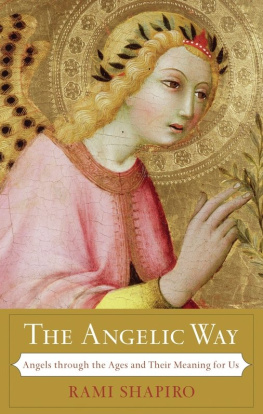SENSE & NONSENSE
ABOUT
ANGELS
& DEMONS
KENNETH D. BOA
ROBERT M. BOWMAN JR.

ZONDERVAN
Sense and Nonsense about Angels and Demons
Copyright 2007 by Kenneth D. Boa and Robert M. Bowman Jr.
All rights reserved under International and Pan-American Copyright Conventions. By payment of the required fees, you have been granted the non-exclusive, non-transferable right to access and read the text of this e-book on-screen. No part of this text may be reproduced, transmitted, down-loaded, decompiled, reverse engineered, or stored in or introduced into any information storage and retrieval system, in any form or by any means, whether electronic or mechanical, now known or hereinafter invented, without the express written permission of Zondervan.
Mobipocket Edition February 2009 ISBN: 978-0-310-29824-3
Requests for information should be addressed to:
Zondervan, Grand Rapids, Michigan 49530
Library of Congress Cataloging-in-Publication Data
Boa, Kenneth D.
Sense and nonsense about angels and demons / Kenneth D. Boa and Robert
M. Bowman Jr.
p. cm.
Includes bibliographical references and index.
ISBN-13: 978-0-310-25429-4
1. Angels. 2. Demonology. I. Bowman, Robert M. II. Title.
BT966.3.B63 2007
235'.3 dc22
2007001534
The Scripture quotations contained herein are from the New Revised Standard Version Bible , copyrighted 1989, Division of Christian Education of the National Council of Churches of Christ in the United States of America, and are used by permission. All rights reserved. All italics in biblical quotations are added by the authors for emphasis. Biblical quotation from other translations will be noted in the text.
A number of Scripture quotations are also taken from: New American Standard Bible, Copyright 1960, 1962, 1963, 1968, 1971, 1972, 1973, 1975, 1977, 1995 by The Lockman Foundation. Used by permission; and the Holy Bible, New International Version . NIV. Copyright 1973, 1978, 1984 by International Bible Society. Used by permission of Zondervan. All rights reserved.
Internet addresses (websites, blogs, etc.) and telephone numbers printed in this book are offered as a resource to you. These are not intended in any way to be or imply an endorsement on the part of Zondervan, nor do we vouch for the content of these sites and numbers for the life of this book.
All rights reserved. No part of this publication may be reproduced, stored in a retrieval system, or transmitted in any form or by any means electronic, mechanical, photocopy, recording, or any other except for brief quotations in printed reviews, without the prior permission of the publisher.
Published in association with the literary agency of Wolgemuth & Associates, Inc.
______________________________________________
07 08 09 10 11 12  15 14 13 12 11 10 9 8 7 6 5 4 3 2 1
15 14 13 12 11 10 9 8 7 6 5 4 3 2 1
CONTENTS

A good case can be made for thinking that there have been enough books written already about angels and demons. We would refuse to add to the pile except for one thing: so much of what has been written is nonsense.
That may sound intolerant or ungracious, but putting it any milder would obscure the point. There are people who report talking to angels for hours on end, yet the message these angels bring sounds suspiciously similar to the pop psychology of the day. Books promise their readers contact with angels on a regular basis, bringing power, healing, prosperity, forgiveness, comfort, revelations, spiritual transformation, and daily guidance of the sort usually associated with horoscopes. Even books that dont make such hyped promises often regale us with one anecdote after another about angelic visitations, leaving all sorts of false impressions about what people can expect from angels. Books about demons likewise often contain generous amounts of drivel, if not dangerous notions. Demons get blamed for everything bad, and even some things that are not bad at all. At the other end of the spectrum, some people are skeptical about the existence of angels or demons.
Our goal in this book is a modest one: to help you think clearly and critically about the subject of angels and demons. To that end, we look at a variety of beliefs about these invisible creatures. Although we are Christians, we identify some nonsense coming from Christian as well as non-Christian sources. In that respect, we are equal-opportunity offenders: we think nonsense should be exposed wherever it may be found, even in our own religious backyard.
Much of this book will focus on getting a clearheaded understanding about just what angels are. Before we begin, though, we should point out that the word angels has at least three meanings.
(1) Sometimes by angels people mean any sort of created spiritual being, including angels in heaven with God and the fallen or wicked angels, also called demons. (2) Sometimes the word angels refers only to the good, heavenly angels, in contrast to the demons (as in our titles reference to angels and demons). (3) Less common today, but still seen occasionally, is the use of the word angels to refer to a specific rank of heavenly beings whose main task is the communication of messages (because the Greek word angelos meant messenger). It will usually be obvious from the context which meaning applies.
Without further ado, then, lets start sorting out sense and nonsense about angels and demons.
A lot of people get carried away with angels, but we still need to think about them.
An awful lot of what people say about angels is nonsense. For centuries people have entertained the wildest speculations about both angels and demons. Weve all heard the question about how many angels can dance on the head of a pin, a question that for many of us epitomizes the fanciful, irrelevant nature of doctrine. Who knows and who cares? we think when we hear a question like that.
A Brief History of Angelology
The study of angelology (the doctrine of angels) played a surprisingly big role in medieval thought. The basic textbook on the subject was a book called Celestial Hierarchy , purported to be authored by Dionysius, an Athenian converted to faith in Christ through the preaching of the apostle Paul (Acts 17:34). Medieval theologians generally accepted the books claim at face value and consequently treated it as an authoritative guide to what the apostles believed about angels. Modern scholars, though, uniformly agree that the book was written centuries later, and so they refer to its author as Pseudo-Dionysius. Well talk more about this angel book in chapter 12.
Angelology reached its heyday in the thirteenth century, when Europes most brilliant minds wrote extensively on the subject and university students (e.g., at Paris) were required to take courses in it. Two thirteenth-century theologians epitomized that eras interest in angels and developed the most thorough, sophisticated systems of angelology the world has ever seen. Thomas Aquinas (1225 74), widely regarded as the most brilliant Christian theologian and philosopher during the long stretch of centuries from the fall of the Roman empire to the Renaissance, was known as the Angelic Doctor. A member of the Benedictine Order, Aquinas devoted a good bit of his classic, multivolume work Summa Theologiae to angels.
Aquinass older contemporary Bonaventure (1217 74) was called the Seraphic Doctor because he was a member of the Franciscans. They were known as the Seraphic Order because Christ was reported to have appeared to Saint Francis in the form of a seraph. Bonaventure himself was said to have been visited by an angel, and he interpreted the sixth angel of the book of Revelation as a reference to Francis.
Next page
















 15 14 13 12 11 10 9 8 7 6 5 4 3 2 1
15 14 13 12 11 10 9 8 7 6 5 4 3 2 1